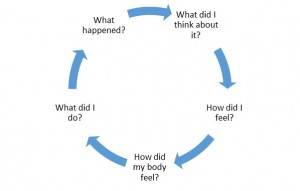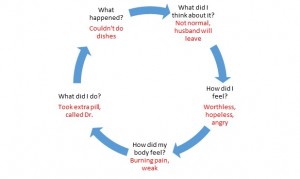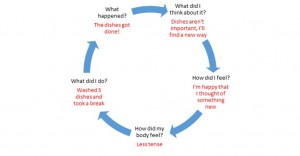10 Minute Mini Lesson One is designed to provide a basic understanding of the CBT concept of Cognitive Restructuring.
Help them fill in the CBT Cycle Diagram to show what happened, what they were THINKING, how they FELT emotionally and physically, and how they BEHAVED:
HERE ARE SUGGESTED QUESTIONS TO ASK. Have patient if able write answer next to appropriate label in Diagram:
- WHAT HAPPENED?
Q: Tell me about a specific, recent time when your pain increased.
A: I got upset because I had too much back pain to even do the dishes.
Q: When?
A: I guess it was 2 days ago
Q: What time of day? (Or other questions like ‘where were you?’ to increase specificity.)
A: In the afternoon
- WHAT WERE THEIR THOUGHTS:
Q: What was running through your mind when [the event] happened?
A: I’ll never be able to do anything normal and my husband will leave me.
Typical THOUGHTS of chronic pain patients:
- Catastrophising
- Unhelp beliefs, e.g., I should always rest, I need to get rid of the pain (vs. manage the pain)
- Hypervigilance, e.g., paying too much attention to one’s body
- Self Criticism
- WHAT WERE THEIR FEELINGS:
Q: How did that make you feel?
A: I felt worthless and hopeless.
Q: Did you have other feelings like [anger, fear, sadness]?
A: Well, I guess anger because this has been going on so long.
Typical FEELINGS of chronic pain patients
- Low mood
- Anger and frustration
- Anxiety and worry
- HOW DID THEIR BODY FEEL?
Q: How did your body feel?
A: My back was on fire. I felt like I couldn’t stand up.
Typical BODY FEELINGS of chronic pain patients
- Pain, weakness, and stiffness
- Lethargy and fatigue
- Poor sleep
- Nervous symptoms
- WHAT DID THEY DO?
Q: What did you do at that point?
A: I took an extra pain pill but it didn’t help, so I called for an appointment.
Typical BEHAVIORS of chronic pain patients
- Sighing and groaning, talking about pain
- Reduced activity; excessive rest
- Social isolation and withdrawalTHIS IS HOW THE CBT CYCLE DIAGRAM MIGHT NOW LOOK:
HELP PATIENT FIND NEW WAY OF THINKING ABOUT EVENT:
Explore using yourself as a model. Use the patient’s own words as much as possible. Help the patient make their own connections and discoveries. Your main goal is to get the patient to THINK DIFFERENTLY about their situation. Much of this THINKING may occur at home after the visit.
OFFER COGNITIVE EMPATHY: If I thought I wasn’t ever going to be normal and my spouse would leave me, I would also feel hopeless and worthless and angry and want the doctor to fix me.
SUGGEST COGNITIVE RESTRUCTURING or REFRAMING:
Q: Is there something different you could THINK about [event}?
THIS IS HOW THE CBT CYCLE DIAGRAM MIGHT NOW LOOK:
HELP PATIENT FIND NEW WAY OF THINKING ABOUT EVENT:
Explore using yourself as a model. Use the patient’s own words as much as possible. Help the patient make their own connections and discoveries. Your main goal is to get the patient to THINK DIFFERENTLY about their situation. Much of this THINKING may occur at home after the visit.
OFFER COGNITIVE EMPATHY: If I thought I wasn’t ever going to be normal and my spouse would leave me, I would also feel hopeless and worthless and angry and want the doctor to fix me.
SUGGEST COGNITIVE RESTRUCTURING or REFRAMING:
Q: Is there something different you could THINK about [event}?
A: I need to find a different way to get this done. Dirty dishes are not the end of the world.
COACH on possible answers if they don’t come up with any on their own.
Q: How might you FEEL if you thought that about the dishes?
A: I’d be happy that I had a good idea. I wouldn’t worry about it as much.
Q: How would your BODY FEEL?
A: Maybe I wouldn’t feel so tense.
Q: What would you DO differently?
A: I’d wash five dishes and then go watch my favorite soap for 10 minutes.
HOMEWORK ASSIGNMENT: Ask patient to fill out a new CBT Cycle Diagram AT HOME with the NEW thoughts, emotional and physical feelings, and behaviors (which might look like this). Encourage patient to use this new skill at least once a day (supply them with blank CBT Cycle Diagram forms). Ensure them that regular practice will lessen their pain, improve their mood and self-confidence, and make them less dependent on medications.
NEXT CBT Mini Lesson: Mindfulness and Relaxation Exercises



